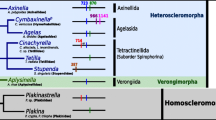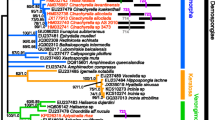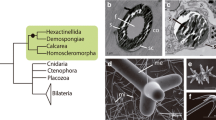Abstract
Silicateins found in spicules of siliceous sponges are proteins that take part in biogenic silica precipitation and determine the morphological features of spicules. The exon-intron structure of the genes encoding four silicatein-α isoforms (−α1, −α2, −α3, and −α4) from an endemic Baikalian sponge Lubomirskia baicalensis was studied. For eight sponge species, including both cosmopolitan (Spongilla lacustris, Ephydatia muelleri, E. fluviatilis) and endemic Baikalian (L. baicalensis, L. incrustans, Baikalospongia intermedia, B. fungiformis, Sw. papyracea) species, seventeen partial sequences of different silicatein isoform genes were determined. It was shown that cosmopolitan and endemic Baikalian sponges differ from each other in gene structure, in particular, in intron length. Among Baikalian sponges, silicatein-α1 genes had the highest variation of intron length, and silicatein-α4 genes were the most conservative. A phylogenetic analysis based on amino acid sequences of different silicatein isoforms identified four distinct clusters within the freshwater sponge clade. An analysis based on exon-intron gene sequences enables discrimination between different sponge species within the clusters.
Similar content being viewed by others
References
Shimizu K., Cha J., Stucky G.D., Morse D.E. 1998. Silicatein alpha: Cathepsin L-like protein in sponge biosilica. Proc. Natl. Acad. Sci. U. S. A. 95, 6234–6238.
Cha J.N., Shimizu K., Zhou Y., Christianssen S.C., Chmelka B.F., Stucky G.D., Morse D.E. 1999. Silicatein filaments and subunits from a marine sponge direct the polymerization of silica and silicones in vitro. Proc. Natl. Acad. Sci. U. S. A. 96, 361–365.
Krasko A., Batel R., Schroeder H.C., Mueller I.M., Mueller W.E.G. 2000. Expression of silicatein and collagen genes in the marine sponge Suberites domuncula is controlled by silicate and myotrophin. Eur. J. Biochem. 267, 4878–4887.
Pozzolini M., Sturla L., Cerrano C., Bavestrello G., Camardella L., Parodi A.M., Raheli F., Benatti U., Mueller W.E.G., Giovine M. 2004. Molecular cloning of silicatein gene from marine sponge Petrosia ficiformis (Porifera, Demospongiae) and development of primmorphs as a model for biosilicification studies. Mar. Biotechnol. (N.Y.). 6, 594–603.
Armirotti A., Damonte G., Pozzolini M., Mussino F., Cerrano C., Salis A., Benatti U., Giovine M. 2009. Primary structure and post translation modification of silicatein beta from the marine sponge Petrosia ficiformis (Poiret, 1789). J. Proteome Res. (http://pubs.acs.org), 1–29.
Cao X., Fu W., Yu X., Zhang W. 2007. Dynamics of spicule production in the marine sponge Hymeniacidon perlevis during in vitro cell culture and seasonal development in the field. Cell Tissue Res. 329, 595–608.
Mueller W.E.G., Boreiko A., Wang X., Belikov S.I., Wiens M., Grebenjuk V.A., Schlobetamacher U., Schroeder H.C. 2007. Silicateins, the major biosilica forming enzymes present in demosponges: Protein analysis and phylogenetic relationship. Gene. 395, 62–71.
Mueller W.E.G., Wang X., Kropf K., Boreiko A., Schlossmacher U., Brandt D., Schroeder H.C, Wiens M. 2008. Silicatein expression in the hexactinellid Crateromorpha meyeri: The lead marker gene restricted to siliceous sponges. Cell Tissue Res. 333, 339–351.
Kozhemyako V.B., Veremeichik G.N., Shkryl Y.N., Kovalchuk S.N., Krasokhin V.B., Rasskazov V.A., Zhuravlev Y.N., Bulgakov V.P., Kulchin Y.N. 2009. Silicatein genes in spicule-forming and nonspicule-forming pacific Demosponges. Mar. Biotechnol. (http://www.springerlink.com/content/g6253r384j8g6lu9/fulltext.pdf), 1–7.
Weaver J.C., Morse D.E. 2003. Molecular biology of Demosponge axial filaments and their roles in biosilicification. Microsc. Res. Techn. 62, 356–367.
Kaluzhnaya O.V., Belikov S.I., Schroeder H.C., Rothenberger M., Zapf S., Kaandorp J.P., Borejko A., Mueller I.M., Mueller W.E.G. 2005. Dynamics of skeleton formation in the Lake Baikal sponge Lubomirskia baicalensis: 2. Molecular biological studies. Naturwissenschaften. 92, 128–133.
Murr M.M., Morse D.E. 2005. Fractal intermediates in the self-assembly of silicatein filaments. Proc. Natl. Acad. Sci U. S. A. 102, 11657–11662.
Mueller W.E.G., Schlobetamacher U., Wang X., Boreiko A., Brandt D., Wolf S.E., Tremel W., Schroeder H.C. 2008. Poly(silicate)-metabolizing silicatein in siliceous spicules and silicasomes of demosponges comprises dual enzymatic activities (silica polymerase and silica esterase). FEBS J. 275, 362–370.
Mohri K., Nakatsukasa M., Masuda Y., Agata K, Funayama N. 2008. Toward understanding the morphogenesis of siliceous spicules in freshwater sponge: Differential mRNA expression of spicule-type-specific silicatein genes in Ephydatia fluviatilis. Dev. Dynam. 273, 3024–3039.
Funayama N., Nakatsukasa M., Kuraku S., Takechi K., Dohi M., Iwabe N., Miyata T. and Agata K. 2005. Isolation of Ef silicatein and Ef lectin as molecular markers for sclerocytes and cells involved in innate immunity in the freshwater sponge Ephydatia fluviatilis. Zool. Sci. 22, 1113–1122.
Kaluzhnaya O.V., Belikova A.S., Podolskaya E.P., Krasko A.G., Muller W.E.G., Belikov S.I. 2007. Identification of silicateins in freshwater sponge Lubomirskia baicalensis. Mol. Biol. (Moscow). 41, 554–561).
Efremova S.M. 2001. Sponges (Porifera). In: Annotirovannyi spisok fauny ozera Baikal i ego vodosbornogo basseina (Index of Animal Species Inhabiting Lake Baikal and Its Catchment Area). Novosibirsk: Nauka, vol. 1, pp. 179–192.
Itskovich V.B., Gontcharov A., Masuda Y., Nohno T., Belikov S.I., Efremova S.M., Meixner M., Janussen D. 2008. Ribosomal ITS sequences allow resolution of freshwater sponge phylogeny with alignments guided by secondary structure prediction. J. Mol. Evol. 67, 608–620.
Ludwig M.Z. 2002. Functional evolution of noncoding DNA. Curr. Opin. Genet. Dev. 12, 634–639.
Atambayeva Sh.A., Khailenko V.A., Ivashchenko A.T. 2008. Intron and exon length variation in Arabidopsis, rice, nematode, and human. Mol. Biol. (Moscow). 42, 312–320.
Hall T.A. 1999. BioEdit: A user-friendly biological sequence alignment editor and analysis program for Windows 95/98/NT. Nucleic Acids Symp. Ser. 41, 95–98.
Phillips A., Janies D., Wheeler W.C. 2000. Multiple sequence alignment in phylogenetic analysis. Mol. Phyl. Evol. 16, 317–330.
Saitou N., Nei M. 1987. The neighbor-joining method: A new method for reconstructing phylogenetic trees. Mol. Biol. Evol. 4, 406–425.
Felsenstein J. 1981. Evolutionary trees from DNA sequences: A maximum likelihood approach. J. Mol. Evol. 17, 368–376.
Ronquist F., Huelsenbeck J.P. 2003. MrBayes 3: Bayesian phylogenetic inference under mixed models. Bioinformatics. 19, 1572–1574.
Tamura K., Dudley J., Nei M., Kumar S. 2007. MEGA4: Molecular Genetics Analysis (MEGA) soft-ware version 4.0. Mol. Biol. Evol. 24, 1596–1599.
Guindon S., Delsuc F., Dufayard J.F., Gascuel O. 2009. Estimating maximum likelihood phylogenies with PhyML. Methods Mol. Biol. 537, 113–137.
Keane T.M, Creevey C.J., Pentony M.M., Naughton T.J., McInerney J.O. 2006. Assessment of methods for amino acid matrix selection and their use on empirical data shows that assumptions for choice of matrix are not justified. BMC Evol. Biol. 6, 29.
King N., Westbrook J., Young S., et al. 2008. The genome of the choanoflagellate Monosiga brevicollis and the origin of metazoans. Nature. 451, 783–788.
Irimia M., Roy S.W. 2008. Spliceosomal introns as tools for genomic and evolutionary analysis. Nucleic Acids Res. 36, 1703–1712.
Efremova S.M., Itskovich V.B., Parfenova V.V., Drucker V.V., Müller W.E., Schröder H.C. 2002. Lake Baikal: A unique place to study evolution of sponges and their stress response in an environment nearly unimpaired by anthropogenic perturbation. Cell. Mol. Biol. 48, 359–371.
Prychitko T., Moore W. 2003. Alignment and phylogenetic analysis of b-fibrinogen intron 7 sequences among avian orders reveal conserved regions within the intron. Mol. Biol. Evol. 20, 762–771.
Author information
Authors and Affiliations
Corresponding author
Additional information
Original Russian Text © O.V. Kalyuzhnaya, A.G. Krasko, V.A. Grebenyuk, V.B. Itskovich, N.A. Semiturkina, I.S. Solovarov, W.E.G. Mueller, S.I. Belikov, 2011, published in Molekulyarnaya Biologiya, 2011, Vol. 45, No. 4, pp. 617–626.
Rights and permissions
About this article
Cite this article
Kalyuzhnaya, O.V., Krasko, A.G., Grebenyuk, V.A. et al. Freshwater sponge silicateins: Comparison of gene sequences and exon-intron structure. Mol Biol 45, 567–575 (2011). https://doi.org/10.1134/S002689331103006X
Received:
Accepted:
Published:
Issue Date:
DOI: https://doi.org/10.1134/S002689331103006X




